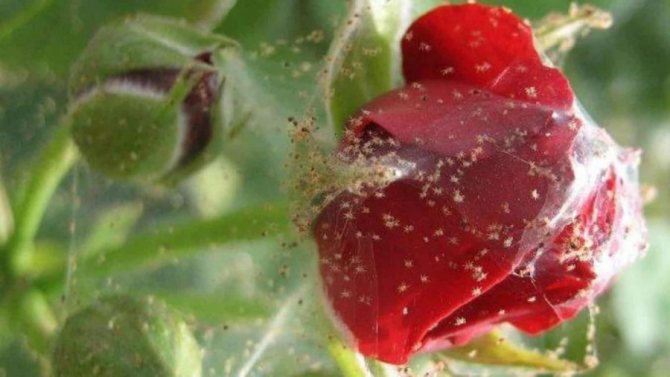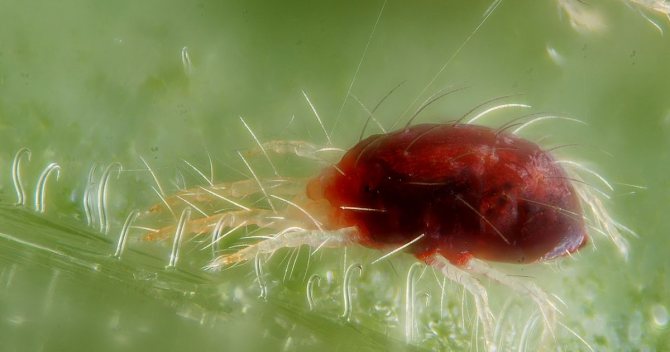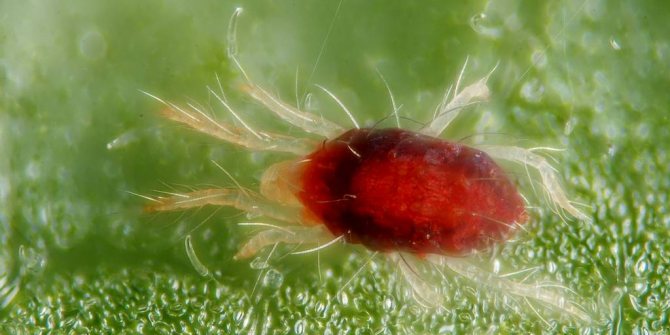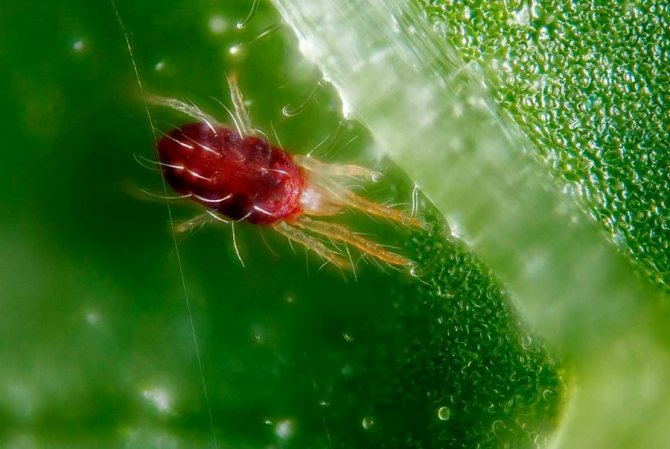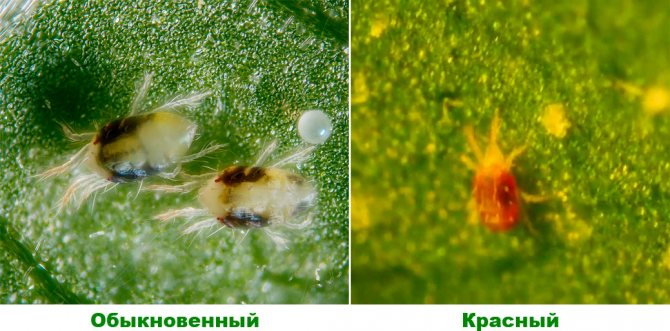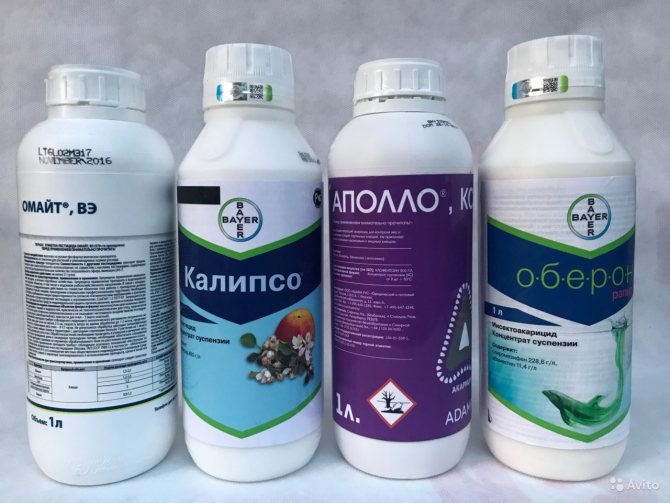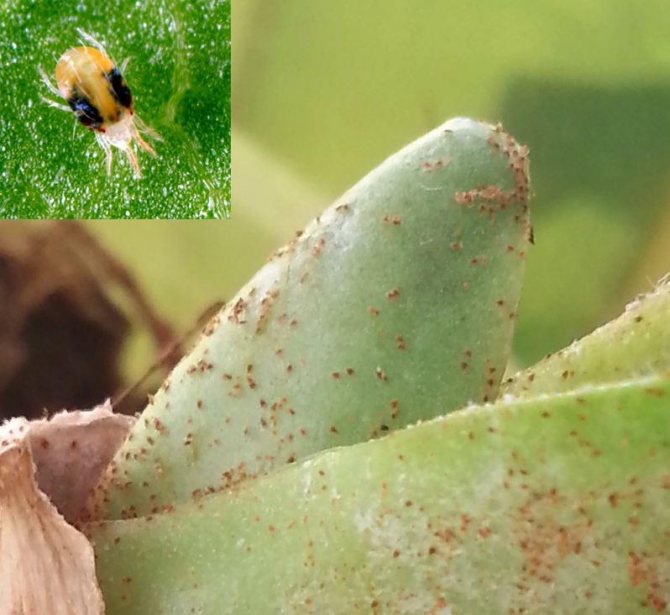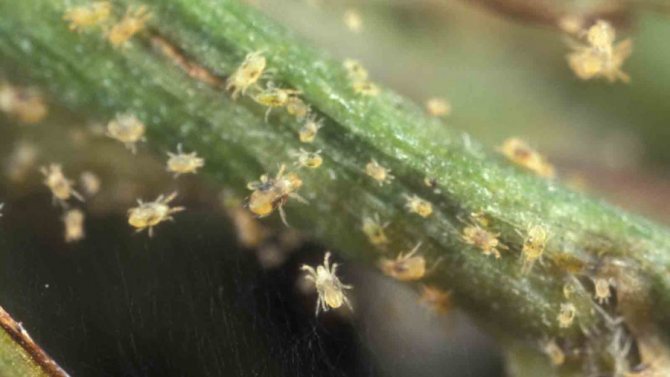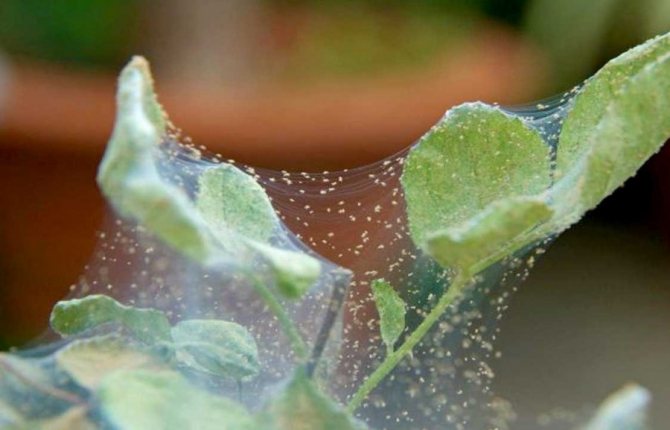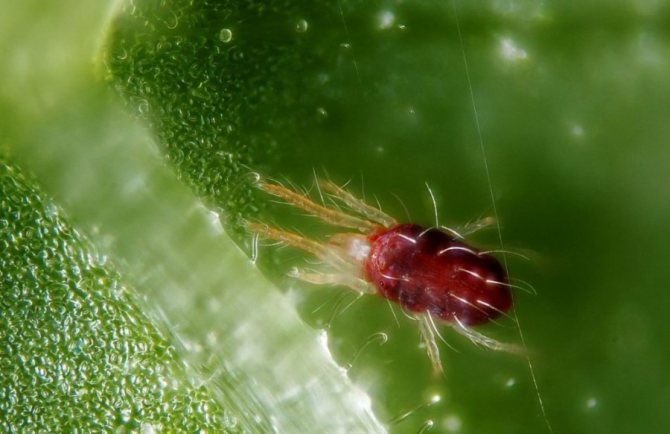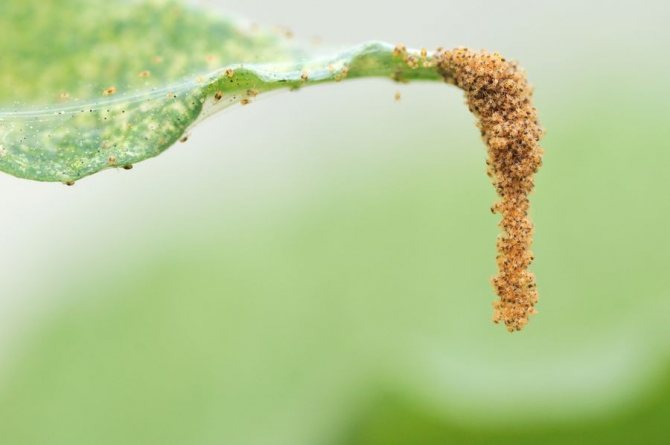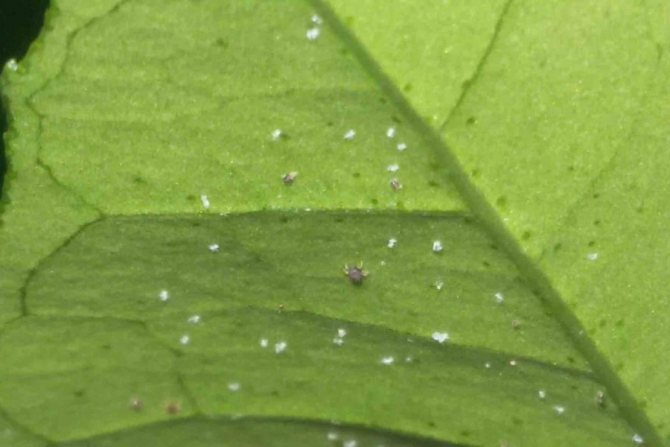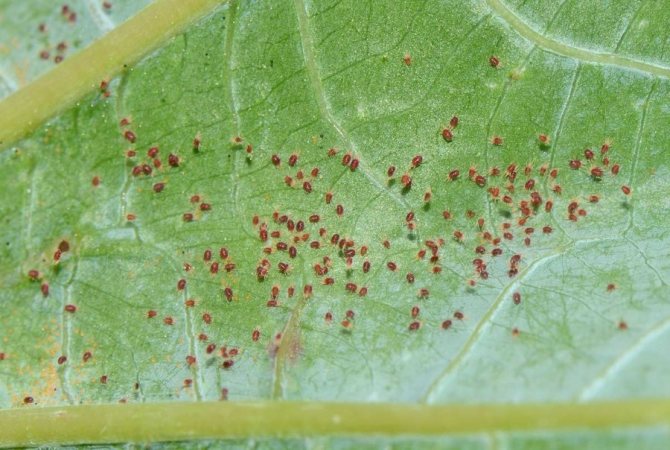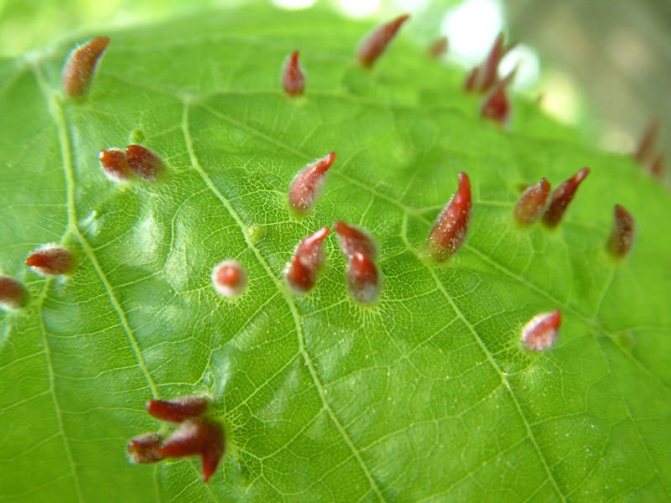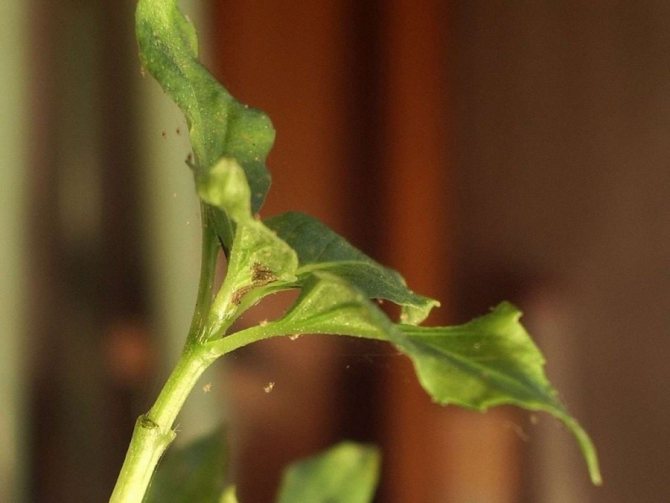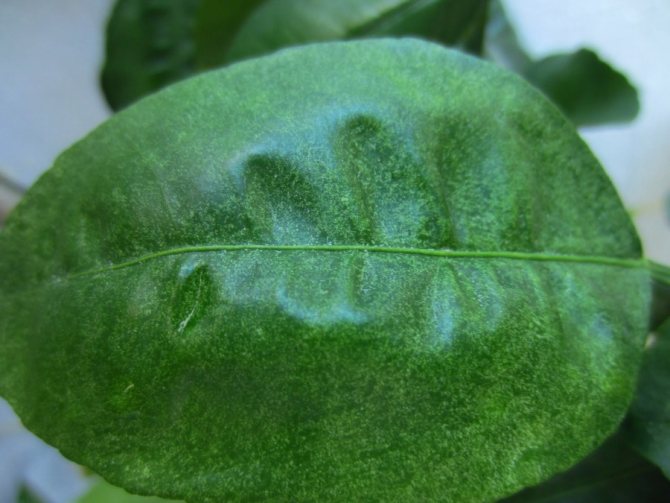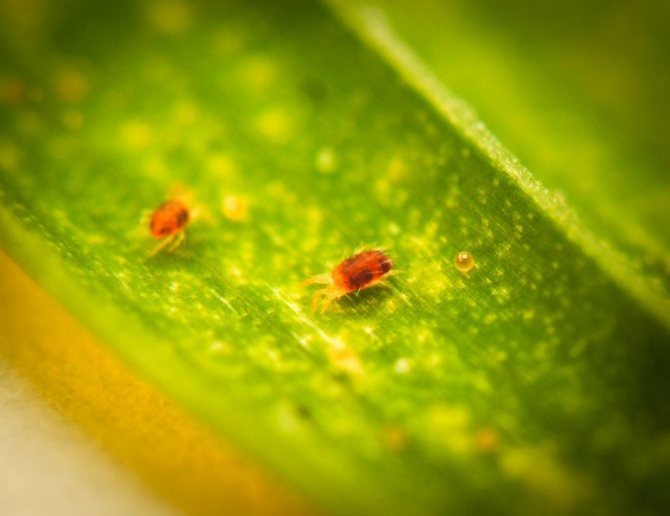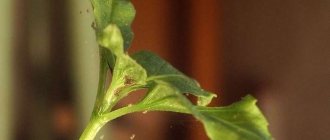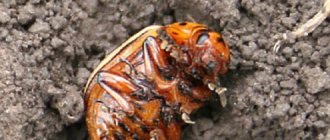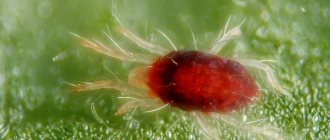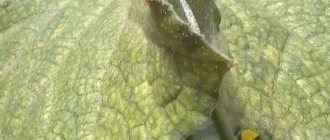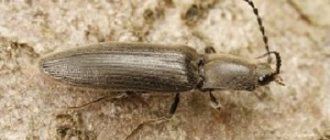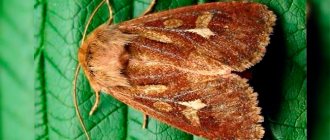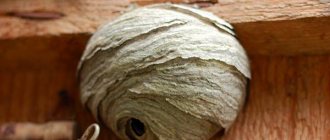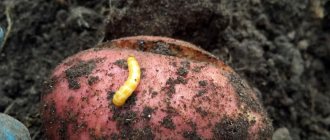Spider mites often infect indoor plants. This small parasite settles on the stems or leaves of flowers. Ticks prefer to stay closer to the root zone, where they suck out sap, interfering with the normal growth and development of the flower.
Almost all growers know how dangerous this insect is. Therefore, it is very important to have the necessary information to detect these parasites and how to fight them.
Today, many methods are known and many drugs have been developed that facilitate the fight against many parasites, including the spider mite. There are also folk remedies that it also makes sense to talk about.
Spider mite description
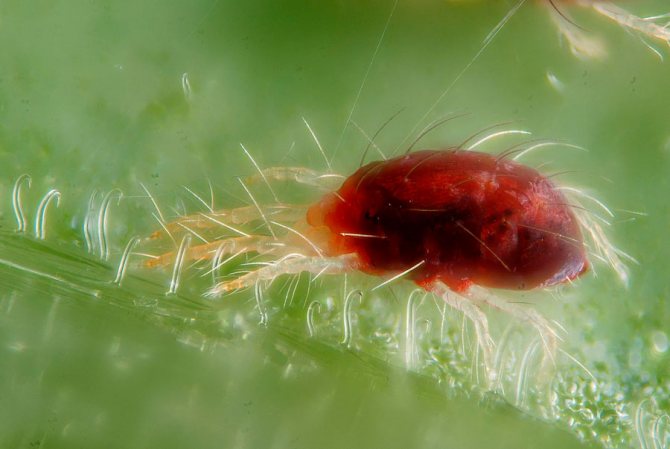
This parasite grows to a length of no more than 1 mm and has an elliptical body shape. Despite their small size, pest colonies can cause significant harm to indoor (indoor) plants if they are not detected in time.
Typically, a tick can be found:
- On the underside of the leaves.
- Between the lumps of soil.
- Under dry fallen leaves.
The spider mite settles in numerous colonies of several hundred insects. The spider mite, together with its larvae, feeds on the sap of houseplants, as a result of which the process of photosynthesis is disrupted, the condition of the soil deteriorates and, as a result, the leaves and buds of plants dry up. Florists know that the fight against this pest can be long if the parasite has chosen a plant. The fact is that the spider mite larvae are highly survivable. Mite eggs can survive for many years in a flower pot, in the bark of plants and in the axils of plants, as well as in cracks in windowsills.
In addition to high vitality, ticks are also quite fertile, which allows them to quickly multiply and capture new territories. The female tick does not live even a month, but lays hundreds of eggs every three days. Therefore, if the parasite on the flower is not found in time, then its larvae quickly spread throughout the flower and then it will be especially difficult to save the flower.
Other folk recipes
In addition to the folk methods described above for destroying a spider mite, there are other time-tested recipes.
Herbal infusions for spraying:


Insist 100 g of red, hot pepper in a liter of water for 3 hours;- Insist 120 g of potato tops for 2-3 hours in a liter of water;
- Insist 40 g of dandelion foliage in water - 1 liter, 2 hours;
- 80 g of yarrow flowers, you can take dry grass, pour boiling water over 1 liter, cool and insist for 2 days;
- Chop 40 g of tomato leaves, brew for 2 hours, cool and spray the flowers.
Reference. All folk formulations are used every 5 days.
You can read more about how to deal with spider mites on indoor and garden plants here.
Varieties of spider mites
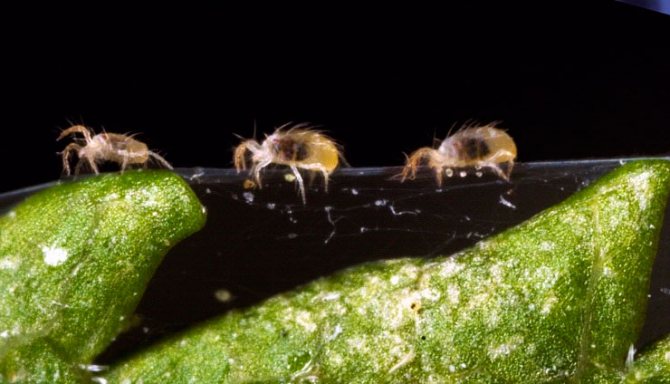

Each mite species prefers to feed on the sap of certain plants. Therefore, it is advisable to know which plants, which mites inhabit. For example:
- Red tick. Prefers flowers such as balsam, lemon, rose, orchid.
- A wide mite is found on ficus, oleander, some types of cactus, euonymus.
- Atlantic tick. Prefers to settle on palms and citrus fruits, as well as other plants. High humidity lover.
- Cactus mite or briobia. As a rule, this parasite chooses exotic plants.
- Clover mite. Prefers bulbous plants, euonymus, orchids, ficus, peneomy.
- Cyclamen mite. Selects flowers such as pelargonium, balsam, violet, chrysanthemum, gloxinia.
- Common mite. It can be seen on rose, dracaena, balsam, fuchsia.
- False tick. A very small parasite that is difficult to recognize with the naked eye. Besides, he does not weave a web. As a rule, most of the flowers on which this dangerous parasite has settled dies.
Preventive measures
There are a lot of ways to get rid of a spider mite, but it is better to use preventive measures:
- you need to keep plants in optimal conditions - dryness and waterlogging, favorable conditions for the growth of the pest population;
- plants need to arrange a shower to remove dirt and dust from the sheets;
- remove dried leaves and inflorescences in time;
- when spraying, add a few drops of neem wood oil to the water.
Also, for prevention, folk remedies for processing plants can be used, only in less concentrated ones.
Reasons for the appearance


As a rule, the main reason for the appearance of a spider mite on indoor plants is the purchase of another flower in a flower shop. Larvae or even adults remain on plants as a result of improper plant care.
Those who buy flowers practically do not examine the plant properly, so the parasites easily move to the windowsills of flower growers or housewives.
There are times when adults enter the dwelling through open windows or doors, if there are green spaces nearby. There is another way of infection, when soil is bought with eggs or larvae of this dangerous pest. Sometimes lovers of indoor plants themselves bring these parasites into their homes when they take soil from the nearest flower garden for transplantation.
Therefore! Each time you buy a new flower, you should carefully examine each leaf of the plant, as well as the soil for the presence of harmful insects. To be on the safe side, it is better to identify the purchased flowers in a separate place, to quarantine. After 2 weeks, if there are no signs of pest activity, the flowers can be identified in their permanent place.
If a spider mite or other parasites are found, you first need to get rid of the pests by any available means. Only after such events can the flower be placed next to other flowers.
Prophylaxis
Once every five to seven days, you need to carefully examine indoor plants, so that when a pest is detected, you can immediately start a fight with it and prevent severe infection. However, it is easier to prevent the appearance of an unpleasant "neighbor"; this can be done, guided by six rules.
- Process the soil. The substrate must be steamed in the oven using non-food baking trays. To protect the moss, you need to pour boiling water over it, wait for the liquid to cool completely and dry it.
- Inspect a new plant. When buying a flower, carefully examine each leaf: there should be no signs of the presence of pests.
- Quarantine. Any plant brought in must be placed separately from other indoor flowers for two weeks. If during this time no signs of a spider mite are found, the flower can be taken to a permanent place. If the pests show themselves, carry out treatment, and only then put the window sill next to other "residents".
- Monitor humidity. Wipe the leaves of the plant with a cloth soaked in hot water, rinsing the cloth more often, every three days. Spray flowers. Do not allow the soil to dry out.
- Keep it clean. Removing fallen leaves immediately is an excellent refuge for spider mites.
- Take care of the flower. It is most difficult for a pest to overcome healthy plants, so it is necessary to provide the "pets" with the necessary conditions: to regularly fertilize, water, create darkening, or, conversely, expose to the sunny side - depends on the "preferences" of the flower.
Trying to maintain the necessary humidity, you can not go too far. Water should not accumulate in the leaf axils and rosettes, as the plant can rot.
Experienced flower growers assure: in case of severe damage by a pest, it is better to discard the plant immediately, since it is unlikely that it will be possible to save it. However, if the indoor flower has retained most of the leaves, it makes sense to fight, but you need to act immediately.
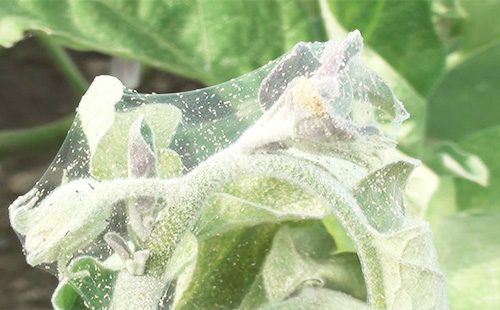

How to recognize a spider mite
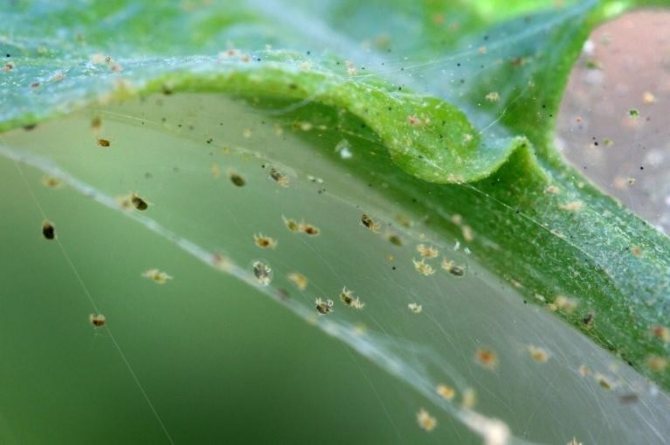

The first signs of mite infection of plants:
- The leaves begin to turn yellow from the bottom. The affected areas lose chlorophyll, discolor and dry out.
- Since the leaves do not receive the required amount of nutrients, they curl up and fall off.
- The places where the spider mite colony has settled are covered with thin cobwebs.
- If you do not start the fight against these pests, then the plant gradually weakens and may die.
Plant treatment plan with drugs
The scheme of plant processing is directly "tied" to the biological cycle of development of the spider mite.
The first spraying is aimed at destroying the bulk of adults. Regardless of the drugs used, the bulk of the pests (70-80%) will be destroyed.
The second should be carried out in a week, when new individuals hatch from the eggs.
The third spraying is carried out again a week later for final destruction.
Many experienced indoor crop lovers add a fourth spray to eliminate possible population residues.
Effective methods of dealing with spider mites


If you identify the pest in time, you can count on an effective outcome. But the problem is that the parasite is very small and very prolific. The body of the insect can merge with the leaves or stems of the plant, which complicates the search process. The easiest way to recognize this parasite is in winter, as females acquire a reddish-brown hue.
When starting the fight against a tick, it is important to know what drugs and what actions can be detrimental to the insect. If, nevertheless, a tick is identified, then you need to focus on an integrated approach in the fight against this parasite. For example:
- If there are not so many larvae and adults, then you can resort to a simple mechanical removal, wiping the places of accumulation with a rag dipped in hot water.
- If the pest is still a little, then various decoctions of greens, vegetables, herbs and flowers, the aroma of which the tick does not tolerate, can help.
- When a sufficient number of ticks have already bred on the plant, biological products can help in the fight.
- If the plant is literally strewn with parasites, then it is better to use potent chemicals that will surely destroy the larvae and adults.
The infected plant is immediately removed from its place and quarantined.
Biologicals
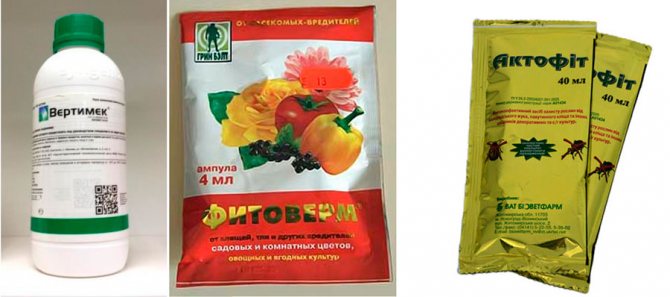

Biologicals are considered to be low-toxic compounds, therefore they are safe for plants and humans. But if there are animals in the house that like to nibble leaves, then they can get hurt. After the first treatment, such means destroy adults and larvae, but eggs and females that can hide in the soil survive. To surely destroy the parasites, it is necessary to carry out about 3 treatments, every 5 days.
Spider mites help:
- Vermitic.
- Fitoverm.
- Aktofit.
- Akarin.
- Kleschevite.
- Agravertine.
Interesting! After processing, it can take from 3 to 7 days before the pests die. These compounds are less toxic, and they work in a different way.Therefore, one should not expect instant destruction of pests or doubt the effectiveness of drugs.
Chemicals


If ticks multiply very quickly and biological products, and even more so, folk methods, do not cope with their task, then it is better to resort to the use of chemicals, the so-called acaricides. Some types of ticks have already managed to adapt to the action of chemicals, so you have to use 2 or even 3 different drugs. In any case, an effective remedy can always be found.
The use of chemicals involves the use of personal protective equipment, along with some rules. For example:
- Wear long sleeves, headwear and gloves.
- For the treatment of indoor plants, it is permissible to use preparations of 3-4 classes of toxicity. More toxic products are intended for outdoor use.
- Before spraying, the root zone is closed so that the chemical composition does not get on the roots. Alternatively, you can use a plastic bag.
- The processing of the plant is carried out strictly according to the instructions. If the flower is seriously affected, then more than one such treatment will be required, but possibly all four, in order to guarantee the destruction of the pest.
Such drugs have such an effect:
- Sunmight.
- Floromite.
- Flumite.
- Apollo.
- Oberon.
Folk remedies for combating spider mites
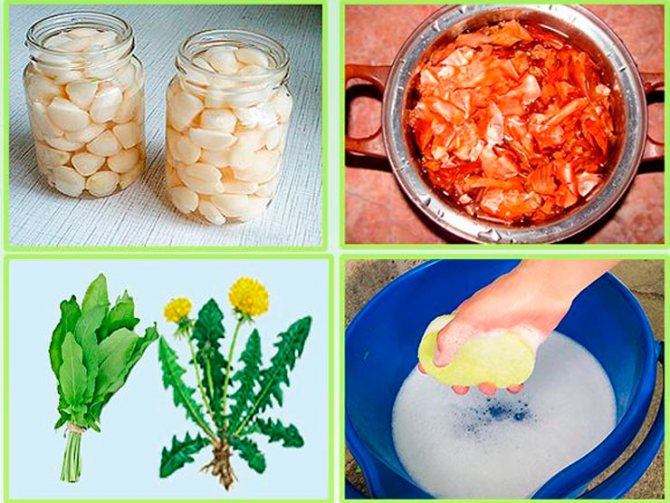

If the parasite has just begun to multiply and did not manage to organize numerous colonies, then you can get by with folk recipes of various compositions. The method is worthy of attention, since it allows several treatments without harm, both for the flower and for others.
You can prepare the following compositions:
- Onion infusion... To do this, take a medium-sized onion and cut it into strips or cubes, then pour boiling water over them. After 4 hours, the infusion is filtered, poured into a spray bottle, and then the leaves are sprayed with this solution.
- Infusion of potato tops... Green raw materials are crushed and filled with 1 liter of boiling water. After 4 hours, the solution is ready for use.
- The use of celandine. To prepare the infusion, take 1 liter of boiling water and pour 2 tablespoons of green or dried celandine leaves into it. After 4 hours, the solution is ready for use.
- Yarrow decoction... You need to take 1 liter of boiling water and 100 grams of yarrow. Boil the solution for 3 minutes, let it brew for 4 hours and can be used, but before that it should be filtered.
- Dandelion infusion... You need to take the leaves and roots of the plant, grind them and take 3 tablespoons, after which the raw material is poured with boiling water. After 4 hours, the solution is filtered and used as directed.
Instructive! Only the upper surface of the leaves is allowed to be treated with soapy water. Respiratory pores are located on the bottom of the leaf. If these pores become covered with soapy foam and then dry out, gas exchange may be disrupted and the leaves will wither.
Zoo shampoos and remedies for fleas or bedbugs
To get rid of spider mites, you can also use animal products aimed at destroying fleas. and bedbugs. They contain acaricides, which are very effective against spider mites; with constant treatment, you can completely get rid of this pest.
"Anti-tick"
This is a highly effective drug that can be used even on a hot summer day. Instructions for the use of "Anti-tick" are very simple: to prepare the composition, you need to dilute the required amount of concentrate in a bucket of water and spray the plants on the day of preparation.
Spider mite protection lasts 2 weeks, after which the processing must be repeated.


